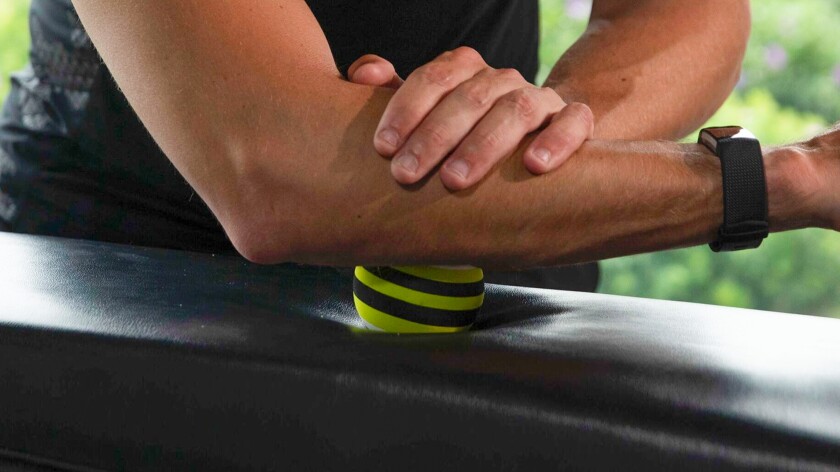Learn to relieve golf elbow pain and adopt proactive steps to prevent golf-related injury in the future
We have all heard of it: the dreaded Golfer’s Elbow.
In the medical community golf elbow is known as medial epicondylitis.
Whatever you want to call it, it’s a common pain that interferes with your golf game and life. At times, it can even become so severe that it can make gripping the club extremely difficult and swinging a club nearly impossible.
What is golf elbow?
Golfer's elbow is a condition in which the forearm tendons that attach on the bony bump on the inside of your elbow become irritated and painful. The condition is related to the repetitive gripping and whipping motion of the wrist that causes the forearm muscles to forcefully contract, creating a tugging action on their tendon attachments.
Over time, this pulling action weakens the tendons and eventually micro damage occurs. Symptoms often include pain, tenderness, and stiffness on the inside of the elbow and upper forearm. These symptoms can build up over time or come on suddenly. They usually worsen with gripping activities such as the golf swing.
Typical, conservative treatment such as rest, ice, and compression helps a bit—but never really gets to the root of the problem so that once you resume activity, the problem returns.
The key to both preventing and treating golfer’s elbow is to take the necessary steps to improve the quality of your forearm function. Remember, the forearm muscles are vital to gripping strength and elbow stability. Stress from the golf swing alters the structure of these muscles so that they shorten and weaken. So, that’s where you must begin.
Pain Free Golf is a realty with GOLFFOREVER Start your FREE TRIAL Today!

1. ROLL & STRETCH
The forearm muscles, just like the muscles of your thighs (quads and hamstrings), need to have the ability to elongate like rubber bands. A great way to keep your muscles pliable is to roll them out using specialized tools. Rolling not only helps to break up forearm adhesions (bands of knotted tissue) that contribute to golfer’s elbow but it also helps to improve flexibility and muscular hydration.
The key to rolling effectively is to apply steady and deep pressure over small areas. When you hit a tender point pause and continue to apply steady deep pressure. Following rolling, the muscles are less restricted, so that they can be further elongated with stretching.
For golfer’s elbow, some simple wrist flexion and extension stretches held for 20 to 30 seconds is extremely effective to rehab and prevent future elbow and forearm problems.
2. STRENGTHEN
Once you have some flexibility in the forearms and the pain levels have begun to subside, begin some simple strengthening exercises. Wrist flexion and extension exercises overloaded with dumbbell weight will create stresses to the forearm muscles and tendons that will lead to greater tissue density.
Remember, the key to rehabbing muscle and tendon ailments is to build them up so that they are more pliable and dense tissue. Flexible and thick tissue—just like flexible and thick rubber bands—are less likely to micro tear.
3. INTEGRATE
Many orthopedic overuse ailments, such as golfer’s elbow, are often related to weaknesses in other areas of the body. If the shoulders or core muscles are weak, for example, then the forearm muscle may have to overwork to compensate.
Incorporating some full-body, integrated exercises can help to establish a rhythm of fluid movement through the body. For the forearms and elbow, some simple diagonal backhand movements can bring the shoulder and hips into the movement and diminish overloading elbow stresses.
4. SUPPORT BRACES
There are several types of forearm straps that can be snuggly fitted just below the elbow to reduce the pulling forces on the tendon attachment. They work fairly well and often help.
Lastly and perhaps most importantly:
5. WARM UP
A combination of all of the above principles in a warm-up program can help prevent and mitigate the effects of golfer’s elbow. Roll for just a minute, stretch for a minute, actively move the wrist and elbow, then integrate the whole body with some tubing exercises such as shoulder backhands. It’s amazing how much better your forearms and elbow will feel when you warm up properly.
Remember, the key to recovering from overuse ailments is to improve the way your body functions. Taking some time to improve the quality of your joints and soft tissues will build your durability and keep you in the game for years to come.
Want to learn more? Visit GOLFFOREVER.COM to build flexibility, mobility, strength and more confidence in your game than ever before.


